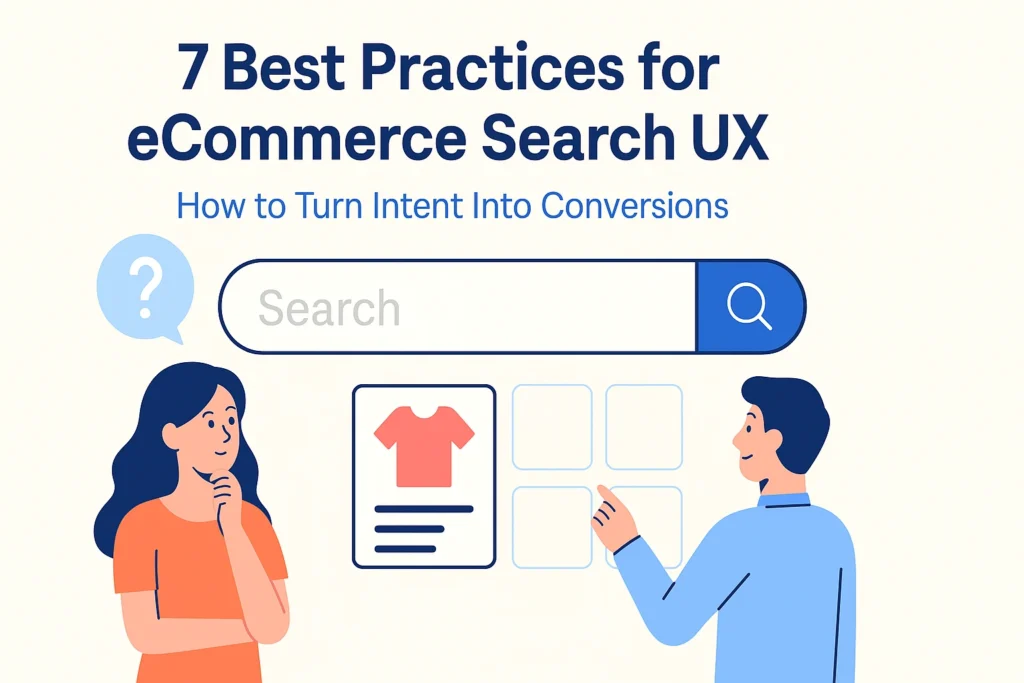In eCommerce, your search bar isn’t a box — it’s the heartbeat of your store. Every query typed into it represents purchase intent.
But if shoppers can’t find what they want quickly, they’ll leave — often for good. According to Google Cloud Retail Insights, 68% of users won’t return to a site after a poor search experience.
That’s why search UX (user experience) is no longer a “nice to have.” It’s a conversion engine. Here are seven best practices, adapted from enterprise search principles, to help your online store deliver smarter, faster, and more intuitive discovery — powered by ExpertRec’s AI-driven site search.
1️⃣ Make Search Easy to Find — and Even Easier to Use
Your search bar is the shopper’s entry point to your catalog. If it’s hidden or poorly designed, you’re creating friction before the experience even begins.
Best practices:
- Place the search bar prominently at the top of every page.
- Use inviting placeholder text: “Search by product, brand, or style.”
- Ensure it’s visible and accessible across devices.
- Keep performance instant — especially on mobile.
💡 With ExpertRec’s search widget, you can add fast, responsive, and fully customizable search across desktop and mobile in minutes.
2️⃣ Guide Users With Autocomplete, Suggestions & Typo Tolerance
Shoppers often type vague or imperfect queries — “blu shooes,” “party wear,” “watch under 5000.”
Good UX anticipates and corrects them. Autocomplete and typo tolerance help users reach the right product faster, reducing frustration and drop-offs.
How to get it right:
- Offer real-time suggestions as users type.
- Recognize and correct spelling mistakes automatically.
- Suggest trending or popular searches (e.g., “Diwali offers,” “summer dresses”).
- Support synonyms and category matches (“hoodie” = “sweatshirt”).
✨ ExpertRec’s AI semantic engine reads intent, not just keywords — interpreting “gift for mom under ₹3000” as a fully contextual product query.
3️⃣ Feature High-Value or Seasonal Results
Some searches deserve more attention than others. For high-intent or seasonal keywords — like “winter jackets,” “Valentine’s gifts,” or “Black Friday deals” — surface featured or promoted products to capture immediate conversions.
Tips:
- Use search rules to promote specific SKUs for high-intent terms.
- Highlight discounts, new arrivals, or trending categories above other results.
- Analyze which keywords drive most revenue and optimize accordingly.
💬 ExpertRec lets merchandisers boost or pin products dynamically — ensuring your most profitable items get prime visibility when it matters most.
4️⃣ Use Search Analytics to Continuously Improve
The best search UX evolves. Analytics reveal what shoppers want, where they struggle, and what drives clicks.
Key insights to monitor:
- Top search queries
- Zero-result searches (missed opportunities)
- Search-to-cart and search-to-checkout rates
- Filter usage and engagement by device
Once you know what users are searching for, you can optimize catalog data, fix gaps, and improve conversion paths.
💡 ExpertRec’s analytics dashboard gives teams real-time visibility into what customers type, find, and buy — turning every search into insight.
5️⃣ Add Spelling Tolerance & Natural Language Understanding
Not everyone types neatly — and fashion shoppers especially don’t. A simple typo shouldn’t break the experience.
Example:
A user searching “blak dress for nite party” should still see “black evening dress.”
How to implement:
- Add typo-correction and “Did you mean?” prompts.
- Train your AI on natural phrasing (“outfit for beach wedding,” “jeans under ₹1500”).
- Recognize regional spelling variants and multi-word terms (“track pants” vs “joggers”).
🔍 ExpertRec’s NLP engine interprets such contextual intent automatically, so users never hit a dead end.
6️⃣ Prioritize Fast, Mobile-First UX
Over 70% of fashion and lifestyle shoppers browse on mobile. If search performance lags or filters are hard to use on small screens, you lose conversions instantly.
Best practices:
- Optimize search latency (<0.5 s ideal).
- Use full-width mobile search with large tap areas.
- Keep filters sticky and scrollable.
- Minimize input steps; autofill where possible.
📱 ExpertRec’s mobile-optimized UI ensures lightning-fast results, smooth scrolling, and tap-friendly filters that keep shoppers browsing longer.
7️⃣ Personalize Results With Contextual Relevance
Generic search results are outdated. Modern shoppers expect your site to “know” them — or at least remember what they last liked.
Personalization makes your search feel human.
How to personalize:
- Re-rank results based on user behavior (clicks, purchases, session history).
- Adjust recommendations using popularity, stock status, and seasonality.
- Serve different search experiences for first-time vs. returning users.
💬 ExpertRec uses AI learning loops to refine relevance automatically — ensuring each visitor sees the most engaging, high-value products for their intent.
⚙️ Putting It All Together: Search UX That Sells
When you combine these seven practices, search becomes the most profitable feature on your site.
With ExpertRec’s AI-powered eCommerce search, you can:
- Deliver hyper-relevant, typo-tolerant search results
- Feature trending and high-margin items dynamically
- Capture user insights for smarter merchandising
- Offer fast, mobile-first discovery experiences
- Personalize results that drive repeat purchases
📈 Retailers using ExpertRec report up to 30 % higher search-to-cart conversions and 40 % fewer zero-result queries within two months of launch.
👉 Transform your site search into a conversion engine with ExpertRec.
🧩 Quick Checklist for Your eCommerce Search UX
✅ Search bar visible and instantly responsive
✅ Autocomplete + typo correction enabled
✅ Product synonyms mapped
✅ Featured results for top terms configured
✅ Mobile filters simplified
✅ Analytics reviewed weekly
✅ AI personalization active
Even one weak link in this chain can hurt the buying experience — so optimize continuously.
❓ Frequently Asked Questions (FAQ)
Q1: What is eCommerce search UX?
It’s the design and functionality that make your online store’s search intuitive, fast, and personalized — helping customers find what they want instantly.
Q2: How does AI improve site search?
AI understands intent and context, not just keywords. It learns from shopper behavior to deliver more relevant and personalized results over time.
Q3: What metrics show that search is working?
Monitor search-to-cart conversion rate, zero-result queries, bounce rate, and time-to-product discovery. A rising trend in these KPIs indicates a healthy search UX.




